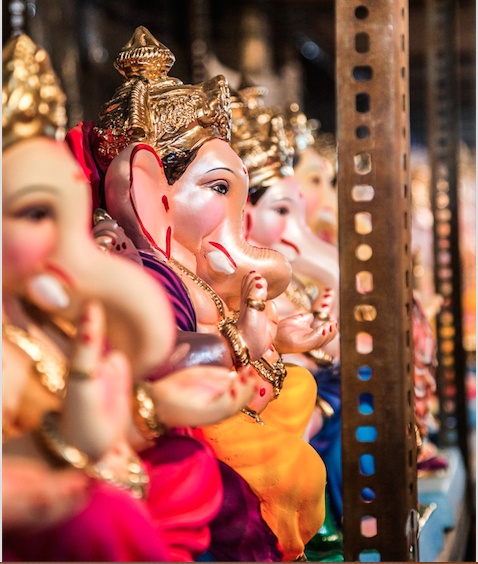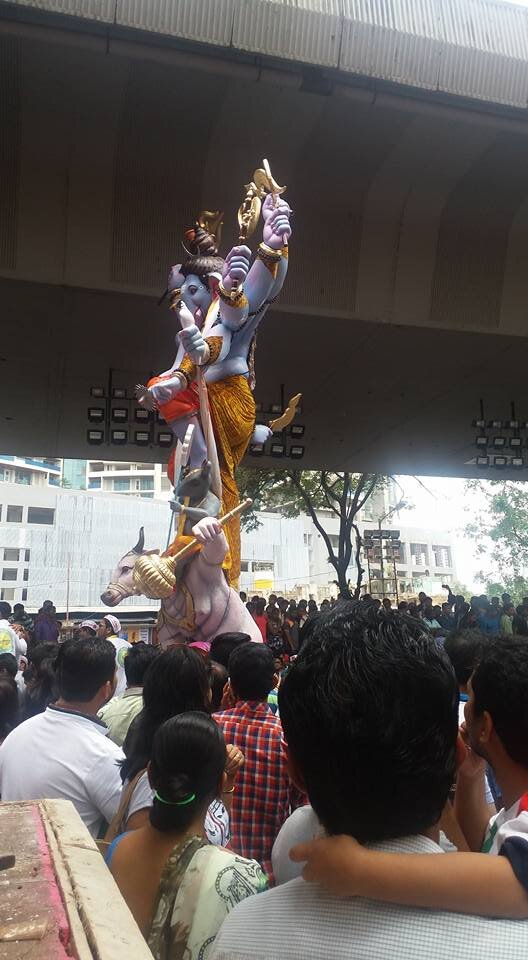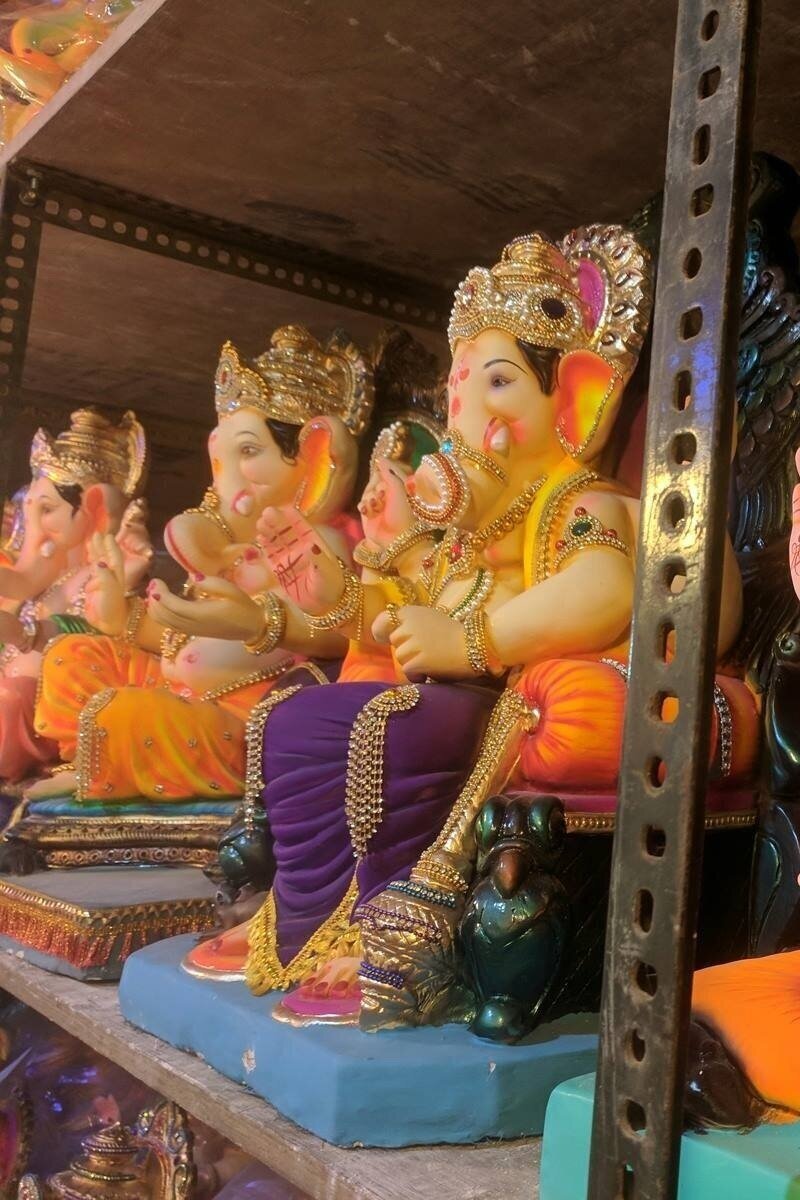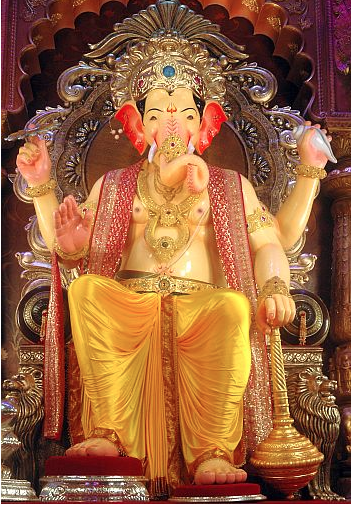LANES OF LALBAUG: IDOL TALK
Each year as the erstwhile mill area of Lalbaug dressed up to welcome the most revered Ganpati idol of Mumbai, Lalbaugcha Raja or the King of Lalbaug, we’d run ‘Lanes of Lalbaug’ to dip into the sea of activity. The idea was to engage with the ganesh shaalas that sprung up in the area, artists giving final touches to the idols, associations busy with erecting tents and pandals to enthrone the idol, the chahal-pahal or hustle bustle that went along with THE time of the year with stories of mills, mill workers, tamasha theatre and artists, aroma of fresh farsan at Chiwda Gali, a tucked in Sufi site (or two!), colourful markets and Marathi Cinema as backdrop.
After ten year of conducting the walk in the pocket, we bowed out last year. Now, at the back of a pandemic with Lalbaugcha Raja Mandal consciously deciding not to hold the Ganesh Utsav and organising a blood and plasma donation camp instead, it will be the first time in 93 odd years that Lalbaug will not have its Raja.
So, in this two-part article we will be putting together some nodes, stories, histories and all that we have learnt and unlearnt over the years for you to take a Lalbaug walk in words. For this year, for now…Remember he is the one who has pudhchya varshi lavkar ya attached to his chant - he will be back next year in better times!
Ganesh Chaturthi marks the birth of Lord Ganesh. The festival falls between 20th August and 15th September, in the month of Bhaarapada, according to Hindu calendar. The modern history of this ten-day festival links back to pre-independence era and Lokmanya Tilak, who saw potential in the power of religious festivals to encourage a desire for political independence. He transformed the festival from a small, domestic scale to a large-scale outdoor event that served as a platform to educate people about the importance of swaraj through fiery speeches.
And the big, outdoorsy Ganpati festival, as it is celebrated today, was born
On the first day of the festival Ganesh Idols are placed in lavishly adorned pavillions erected by various mandals of associations amidst pomp and puja. The idols are immersed on different days of the ten-day long festival however the bigger, more revered idols are immersed on the last two days especially on the final day or Anant Chaudas. Placed on flat bed trucks, the idols are carried to the sea for visrajan or the immersion ceremony in a grand procession with dance, dhol, DJ and cries of Ganpati Bappa Morya…
On the fifth or the sixth day of the festival another major ceremony is performed in many households, Gauri Pujan or Mangala Gauri, to honour the mother of Lord Ganesh. The Gauri idol is brought home one day before the puja, adorned with green bangles, mangalsutra, nose ring and veni. Then, the women get together and sing mangala gauri songs that reflect the life of married Hindu women. After the puja, women visit each other’s homes and offer coconut, cloth, flowers, bananas, rice and even new sarees to the idol and one the next day, usually the sixth day of Ganpati festival, the idols are taken in a procession to be immersed. The first Gauri puja is considered very important for a newly married Maharashtrian woman.
Central to all celebrations is the idol. You see the idols lined up in shops at Ganesh Galli in Lalbaug and scores of artisans milling around providing last minute touches to the idols in makeshift Ganesh Shaalas, held up by Bamboo and blue tarpaulin. Some hold gigantic idols in vibrant colours while some specialise in small ones – rows upon rows of Ganesh Idols seated, reclining a’la Buddha, standing, playing an instrument, in the likeness of other Gods or a character from a blockbuster film wait to be chosen by devotees.
‘Made in Penn’ idols command higher prices than ones made in Mumbai or elsewhere. Penn has over five hundred units manufacturing idols that craft, sculpt, design, paint and are a source of employment to many. In Mumbai, migrants from UP and Bihar find easy employment and form almost half of city’s idol making workforce. Some college students join in for the experience and extra pocket money. Money or enthusiasm, being a participant in Ganpati idol making is considered a humbling experience for most artisans.
Originally, clay was used to make the idols but to make the idol lighter, cheaper and more attractive, Plaster of Paris started being used. The paints also moved from natural to non-biodegradable. Interestingly, according to ancient Hindu scriptures Ganesh was created from the dirt off Goddess Parvati’s body and it is appropriate that the idol is created with something like clay or mud. Plaster of Paris come with its own challenges – apart from polluting the water, it does not disintegrate easily and many a times the idols or their parts are seen floating in the water after immersion. In the past twenty-thirty years, there has been a trend of large(r) idols, as tall as fifty feet or more and even standing idols.
According to the science of making idols or murtivigyan the height of the idols should ideally not be more than 5 or 6ft tall, ideally in a seated position. Idols standing for more than a day or two exert weight on the feet or the base and there are more chances of it cracking, which is considered inauspicious. Anyhow, with more awareness, there has been a greater thrust to make eco-friendly idols, revert to mud and natural, water based paints and immerse the idols at home, in buckets.
That brings us to the other problem that the festival faces – abandoned idols. The well known and sought after idol makers make Ganesh idols to order but some make idols in anticipation of sale. In a city where space is scarce and costly, and most idol makers rent a room or a temporary shed, the unsold idols have no place to go. At times, they dissolve the idols in buckets of water and reuse the clay, break them or just abandon then in Dadar – Lalbaug belt of Mumbai. Since they cannot be disposed off at dumping grounds due to religious sentiments, the idols are picked up either by Municipal workers or NGOs working with BMC, and submerged in the sea. Not an ideal idol disposal situation but that’s how things stand, for now.
Amongst all the associations and idols in Mumbai, the pride of the place belongs to the famous Lalbaugcha Raja (King of Lalbaug). The mandal is the biggest, most revered and oldest. It attracts an average of 1.5 million devotees each day with the crowds swelling on weekends, Gauri puja and on immersion day. The mandal, known as the Sarvajanik Ganeshotsav Mandal, Lalbaug was founded in the year 1928. The Lalbaug Market at Peru Chawl was shut down in 1932 and the fishermen and vendors who used to sit in the open place prayed to Lord Ganesh for a permanent place. With the consistent efforts of the local councillor, the landlord, Rajabai Tayyabali agreed to give a plot for the construction of a market. As their wish was fulfilled, the fishermen and the traders placed the Ganesh Idol in the area on 12th September 1934, dressed in the customary fashion of the fishermen. Since that day, people believe that Lalbaugcha Raja is navsacha Ganesh or one associated with wish fulfilment, making it one of the most famous Ganpati in Mumbai.
Lalbaug cha Raja, King of Lalbaug, Mumbai
The idol of Lalbaugcha Raja is annually made by Kambli Arts. Late Madhusudan Kambli was commissioned to sculpt the Raja in 1935 and since then the Kambli’s have taken the responsibility to sculpt Lalbaug cha Raja. In 1935, the height of the idol was 5 feet but now the height has been fixed at 14 and the though the eyes, face and the body of Lalbaug cha Raja remain constant, the decorations have become elaborate year on year. Interestingly, a patent protects the idol and Kambli Arts has been granted sole rights and ownership for the Ganpati idol pattern.
While the Kamblis sculpt, Pawar stitches a special line of clothing for Lalbaugcha Raja with a team of four or five people. Though the idol wears similar set of clothes, they are changed twice a day – one at 3 am and again at 3pm. In total, twenty-three sets of clothes are required for the 10-day festival. Though many famous designers have expressed a desire to dress the city’s most famous Ganesha, the association trusts Pawar’s skills to clothe him. On the first day of the festival, the idol is dressed in 39 metres long pitambar or yellow dhoti, along with a 6metres long stole and a waist belt. Apart from this, the idol is also adorned with about 7 to 8 kg gold.
Located a couple of lanes away from the Lalbaugcha Raja is the Mumbaicha Raja in Ganesh Lane. It was formed for the benefit of the mill workers in 1928, making it the oldest one in the area. The mandal is well known for its novel themes every year -often a replica of a famous temple in India.
So much about the festival, two main pandals of Lalbaug and a bit about the idols. During the festival, one is so focussed on Ganpati darshan or navigating the crowd and that one hardly notices the Lalbaug neighbourhood – in the next part we will unfurl it all as we walk the Lanes of Lalbaug.
Whatever be the case, Mumbai dressed up for Lord Ganesh is an experience that one should not miss. The air is electric. You just have to get your feet in, admire the idols, walk with the crowd, dance, eat and join in the cheer with Ganpati Bappa Morya!
Idol Talk, Lanes of Lalbaug Poster, Beyond Bombay, Vaydehi.K
To be continued…Lanes of Lalbaug - Idol Walk








